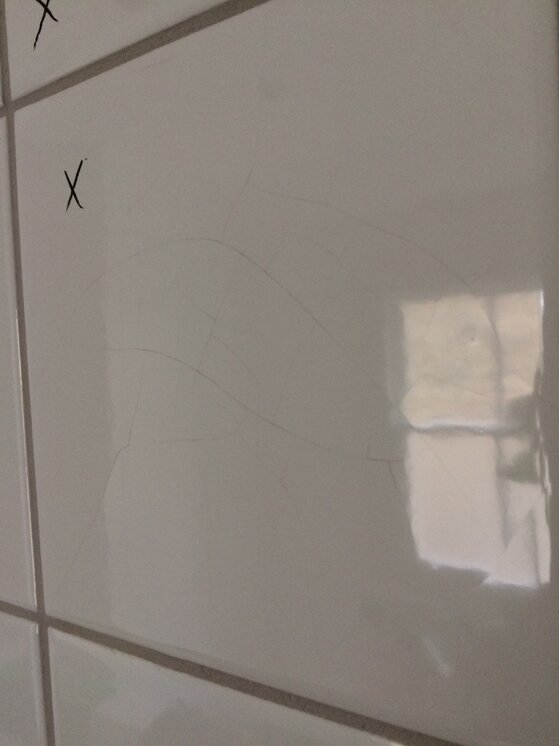A
A274
I'm a customer not a tiler but seeking advice please:
I had two bathrooms fitted in Jan/Feb and in late March noticed some tiles had cracks in - fine cracks in the glaze in webbed patterns (NOT directional cracks that you might see where movement has occurred in wall behind tiles). See attached image. In some places the cracks are even worse and seems as though the whole tile has cracked not only the glaze.
I called the builder back and he is blaming the tiles. However I don't think this is the case as the problem only occurs on some of the walls and not others (all walls were tiled from the same batch of tiles).
The difference between the surfaces that have cracked and the ones that haven't is the thickness of the adhesive used. Where it has been thinly applied - (<6mm which is the max depth you should use according to the instructions on the adhesive packet - 'Topps Rapid Set flexible') the tiles are fine, but where it has been used at greater depths (in some places as much as 24mm has been applied) there are cracked tiles. About 13 m2 of tiles are affected.
I would greatly appreciate any advice on what the cause is and how to fix the problem.
Additional details:
Tiles are Topps diamond white matrix tiles which I know are 'cheap' but I used them in a previous bathroom and inside the shower with no problems at all (installed by a different builder/tiler).
Tiles have been applied to a variety of surfaces: wedi board, waterproof ply, waterproof plasterboard, existing plastered walls, but the walls were not made level / square at this point in the process, instead the builder relied on thick application of tile adhesive to correct.
The cracks have only occurred where the tiles were applied over wedi board or plywood, not to any of the existing plastered walls or 'boxed in' structures built from waterproof plasterboard.

I had two bathrooms fitted in Jan/Feb and in late March noticed some tiles had cracks in - fine cracks in the glaze in webbed patterns (NOT directional cracks that you might see where movement has occurred in wall behind tiles). See attached image. In some places the cracks are even worse and seems as though the whole tile has cracked not only the glaze.
I called the builder back and he is blaming the tiles. However I don't think this is the case as the problem only occurs on some of the walls and not others (all walls were tiled from the same batch of tiles).
The difference between the surfaces that have cracked and the ones that haven't is the thickness of the adhesive used. Where it has been thinly applied - (<6mm which is the max depth you should use according to the instructions on the adhesive packet - 'Topps Rapid Set flexible') the tiles are fine, but where it has been used at greater depths (in some places as much as 24mm has been applied) there are cracked tiles. About 13 m2 of tiles are affected.
I would greatly appreciate any advice on what the cause is and how to fix the problem.
Additional details:
Tiles are Topps diamond white matrix tiles which I know are 'cheap' but I used them in a previous bathroom and inside the shower with no problems at all (installed by a different builder/tiler).
Tiles have been applied to a variety of surfaces: wedi board, waterproof ply, waterproof plasterboard, existing plastered walls, but the walls were not made level / square at this point in the process, instead the builder relied on thick application of tile adhesive to correct.
The cracks have only occurred where the tiles were applied over wedi board or plywood, not to any of the existing plastered walls or 'boxed in' structures built from waterproof plasterboard.


